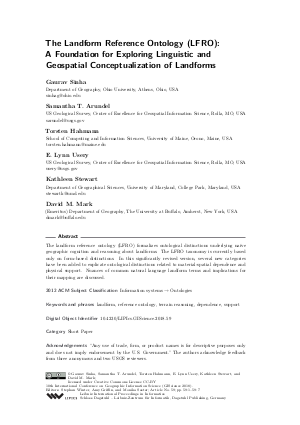The Landform Reference Ontology (LFRO): A Foundation for Exploring Linguistic and Geospatial Conceptualization of Landforms (Short Paper)
Authors Gaurav Sinha, Samantha T. Arundel, Torsten Hahmann, E. Lynn Usery, Kathleen Stewart, David M. Mark
-
Part of:
Volume:
10th International Conference on Geographic Information Science (GIScience 2018)
Part of: Series: Leibniz International Proceedings in Informatics (LIPIcs)
Part of: Conference: International Conference on Geographic Information Science (GIScience) - License:
 Creative Commons Attribution 3.0 Unported license
Creative Commons Attribution 3.0 Unported license
- Publication Date: 2018-08-02
File

PDF
LIPIcs.GISCIENCE.2018.59.pdf
- Filesize: 311 kB
- 7 pages
Document Identifiers
Subject Classification
ACM Subject Classification
- Information systems → Ontologies
Keywords
- landform
- reference ontology
- terrain reasoning
- dependence
- support
Metrics
- Access Statistics
-
Total Accesses (updated on a weekly basis)
0Document
0Metadata
Abstract
The landform reference ontology (LFRO) formalizes ontological distinctions underlying naïve geographic cognition and reasoning about landforms. The LFRO taxonomy is currently based only on form-based distinctions. In this significantly revised version, several new categories have been added to explicate ontological distinctions related to material-spatial dependence and physical support. Nuances of common natural language landform terms and implications for their mapping are discussed.
Cite As Get BibTex
Gaurav Sinha, Samantha T. Arundel, Torsten Hahmann, E. Lynn Usery, Kathleen Stewart, and David M. Mark. The Landform Reference Ontology (LFRO): A Foundation for Exploring Linguistic and Geospatial Conceptualization of Landforms (Short Paper). In 10th International Conference on Geographic Information Science (GIScience 2018). Leibniz International Proceedings in Informatics (LIPIcs), Volume 114, pp. 59:1-59:7, Schloss Dagstuhl – Leibniz-Zentrum für Informatik (2018)
https://doi.org/10.4230/LIPIcs.GISCIENCE.2018.59
BibTex
@InProceedings{sinha_et_al:LIPIcs.GISCIENCE.2018.59,
author = {Sinha, Gaurav and Arundel, Samantha T. and Hahmann, Torsten and Usery, E. Lynn and Stewart, Kathleen and Mark, David M.},
title = {{The Landform Reference Ontology (LFRO): A Foundation for Exploring Linguistic and Geospatial Conceptualization of Landforms}},
booktitle = {10th International Conference on Geographic Information Science (GIScience 2018)},
pages = {59:1--59:7},
series = {Leibniz International Proceedings in Informatics (LIPIcs)},
ISBN = {978-3-95977-083-5},
ISSN = {1868-8969},
year = {2018},
volume = {114},
editor = {Winter, Stephan and Griffin, Amy and Sester, Monika},
publisher = {Schloss Dagstuhl -- Leibniz-Zentrum f{\"u}r Informatik},
address = {Dagstuhl, Germany},
URL = {https://drops.dagstuhl.de/entities/document/10.4230/LIPIcs.GISCIENCE.2018.59},
URN = {urn:nbn:de:0030-drops-93873},
doi = {10.4230/LIPIcs.GISCIENCE.2018.59},
annote = {Keywords: landform, reference ontology, terrain reasoning, dependence, support}
}
Author Details
- US Geological Survey, Center of Excellence for Geospatial Information Science, Rolla, MO, USA
- School of Computing and Information Sciences, University of Maine, Orono, Maine, USA
- US Geological Survey, Center of Excellence for Geospatial Information Science, Rolla, MO, USA
- Department of Geographical Sciences, University of Maryland, College Park, Maryland, USA
References
-
Niclas Burenhult and Stephen C. Levinson. Language and landscape: a cross-linguistic perspective. Language Sciences, 30(2):135–150, 2008.

-
Torsten Hahmann and Boyan Brodaric. The void in hydro ontology. In Proceedings of FOIS 2012, page 45–58. IOS Press, 2012.

-
Torsten Hahmann and Boyan Brodaric. Kinds of full physical containment. In Proceedings of COSIT 2013, LNCS 8116, page 397–417. Springer-Verlag New York, Inc., 2013.

-
Torsten Hahmann, Boyan Brodaric, and Michael Grüninger. Interdependence among material objects and voids. In Proceedings of FOIS 2014, page 37–50. IOS Press, 2014.

-
Torsten Hahmann and Shirly Stephen. Using a hydro-reference ontology to provide improved computer-interpretable semantics for the groundwater markup language (gwml2). International Journal of Geographical Information Science, 32(6):1138–1171, 2018.

-
Torsten Hahmann and E. Lynn Usery. What is in a contour map? In Proceedings of COSIT 2015, LNCS 9368, page 375–399. Springer-Verlag New York, Inc., 2015.

-
David M. Mark and Barry Smith. Do mountains exist? Towards an ontology of landforms. Environment and Planning B: Planning and Design, 30(3):411–427, 2003.

-
David M. Mark and Barry Smith. A science of topography: Bridging the qualitative quantitative divide. In Michael P. Bishop and John F. Shroder, editors, Geographic Information Science and Mountain Geomorphology, page 75–100, Chichester, England, 2004. Springer-Praxis.

-
David M. Mark and Andrew G. Turk. Landscape categories in yindjibarndi: Ontology, environment, and language. In Proceedings of COSIT 2003, LNCS 2825, pages 28-–45. Springer International Publishing, 2003.

-
Claudio Masolo, Stefano Borgo, Aldo Gangemi, Nicola Guarino, and Alessandro Oltramari. Wonderweb deliverable d18 - ontology library (final report). Technical report, IST Project 2001-33052 WonderWeb: Ontology Infrastructure for the Semantic Web, 2003.

-
Konrad Rybka. Between objects and places: The expression of landforms in Lokono (Arawakan). International Journal of American Linguistics, 81(4):539–572, 2015.

-
Gaurav Sinha, Samantha T. Arundel, Kathleen Stewart, David M. Mark, Torsten Hahmann, Boleslo E. Romero, Alexandre Sorokine, E. Lynn Usery, and Grant MacKenzie. A reference landform ontology for automated delineation of depression landforms from dems. In Proceedings of Workshops and Posters, COSIT 2017, page 111–116. Springer International Publishing, 2017.

- Gaurav Sinha, Dave Kolas, David M. Mark, Boleslo E. Romero, E. Lynn Usery, and Gary Berg-Cross. Surface network ontology design patterns for linked topographic data. Semantic Web, 2014. Manuscript to be re-submitted to Semantic Web. Draft version available online @ URL: http://www.semantic-web-journal.net/system/files/swj675.pdf.
-
Gaurav Sinha, David M. Mark, Dave Kolas, Dalia Varanka, Boleslo E. Romero, Chen-Chieh Feng, E. Lynn Usery, Joshua Liebermann, and Alexandre Sorokine. An ontology design pattern for surface water features. In Proceedings of GIScience 2014, LNCS 8728, page 187–203. Springer International Publishing, 2014.

